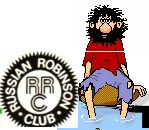 In the middle of nowhere, Russian Robinson Club member Merle Elson, 65, felt a weird pain in his chest.
In the middle of nowhere, Russian Robinson Club member Merle Elson, 65, felt a weird pain in his chest.
The New Mexico resident was with fellow members Yuri Sushkin, Yuri Zaruba and Alexander Kuznetsov on a weeklong expedition at the end of July on Chirikof Island, 180 miles southwest of Kodiak city.
They had to radio for a floatplane to get Elson. He was having a heart attack.
It took an hour and a half for a plane to arrive after sending out a message using ham. or amateur hobby, radio. The message had to be sent to Europe before making its way to America.
“Basically it was a link from Alaska, to Siberia, then Moscow, from Moscow to the United States and then basically we got somebody from California and Alaska,” Sushkin said.
An EMT came by plane, and Elson is back in New Mexico.
“We never had an emergency like this, and we never had so fast of a response,” Sushkin said. “It was hams who called and corresponded right away.
“The most important thing is amateur radio actually works, and saved a life. Ham radio is kind of in the background always … but amateur radio worked 100 percent.”
While the emergency may be a first for the group, traveling to remote islands is not.
Members of the Russian Robinson Club are amateur radio enthusiasts interested in expeditions to the Arctic, Antarctic or difficult to reach islands to establish island stations or activate an amateur radio.
Once established, other ham operators contact them and earn points through the Islands on the Air program.
“The goal was to be the first, and probably the only one for X amount of years because it is so difficult, far and not friendly, to go to the islands,” Sushkin said.
Joe Stevens, a member of Kodiak Amateur Radio Emergency Services, said it’s a program that covers a lot of rare places.
“They create various programs to award certificates for contacting the most of something — states, countries or islands,” Stevens said.
He said some expeditions go to even more remote and inhospitable places, but it is a hobby that hams are willing to spend money for.
“They get money from people who want to contact those places, use their own money and use money or equipment from manufacturers like Nikon,” Stevens said.
The object is mainly to enable amateurs to contact other amateurs around the world and foster a unique friendship. For the Robinson Club, it also gives them an adventure.
“We go on expeditions to places where nobody has been before,” Sushkin said. “It’s very exciting.”
The club is about 16 years old, and has about 1,000 members worldwide from about 50 countries.
“Not all of them go on expeditions,” Sushkin said. “Most of them sit in a warm, nice place on the radio.”
The group has done an Alaska program for the last three years, once per year.
“It’s difficult logisticwise and expensive,” Sushkin said.
In 2008, the group went to Chuginadak Island. While there, the volcano that makes up the western half of the island erupted.
The group still landed there, and made a documentary about it.
Last year the group went to Ogliuga Island, 100 miles west of Adak, by boat.
This year they used a floatplane to get to Chirikof Island.
While on the island, the group ran into another difficulty aside from a heart attack.
About 100 years ago, Russians brought cows to the island and they were never managed successfully. These cows gave the group an unwelcome experience.
“At about 100 feet they started running at us,” Sushkin said. “I was wearing a red jacket and Yuri (Zaruba) was yelling at me, ‘Take it off, take it off, take it off.’ I had a shotgun on me but my hand was sore, I couldn’t lower it. It was like, we’re pretty much dead, but for some reason they turned right around us and went back down.”
The animals on the island were not afraid of them.
“The foxes just come into camp and say, ‘Hey, what you guys doing here?’” Sushkin said.
The group would like to turn their adventure into a documentary similar to the 2008 video they made about Chuginadak Island.
They’d like to include history of Chirikof, as well as a look at Kodiak’s past and present.
“We give some away and sell some to finance our future expeditions, but it really doesn’t work that way,” Sushkin said.
Zaruba, president of the Robinson Club, said despite the medical scare, wild cow showdown and weather and logistics hardships, the expedition was a success.
“It’s a very important expedition for amateur radio because Kodiak Island only has a few ham radio users,” he said.
He was also happy to be back on dry land.
“Our expeditions work in very difficult conditions,” he said. “Cold, fog, moisture. And now we come back to civilization, and we can drink beer.”
Coming to Kodiak gave the group the chance to meet with local government and other figures such as Sergey Morozov of Global Seafoods in Kodiak and Woody Knebel of Ocean Beauty of Alitak who helped make the expedition a success.
“Without those guys it never would have happened,” Sushkin said.
Zaruba said ham radio is fun because there are so many diverse people into it.
“People from different backgrounds, they have the same hobby which is amateur radio,” he said. “Some are engineers, some of them mayors.”
Kuznetsov is mayor of Uvarovo City in Russia.
The three of them plan to keep sharing the hobby of amateur radio. Zaruba has been a ham since 1982, and Kuznetsov and Sushkin since the early 1990s.
“There’s just a couple of islands left in Alaska,” Sushkin said. “They’ll be difficult to get to.”
Mirror writer Louis Garcia can be reached via e-mail at lgarcia@kodiakdailymirror.com.
